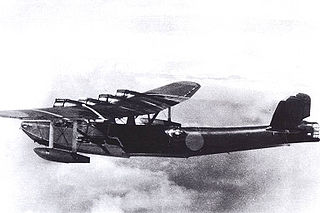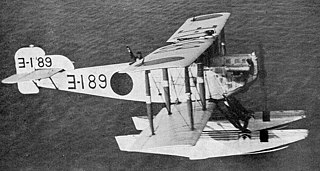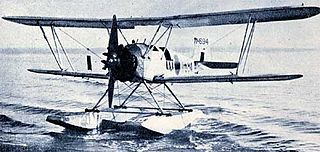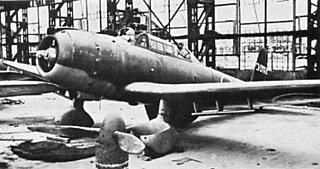Related Research Articles

The Kawanishi H6K was an Imperial Japanese Navy flying boat produced by the Kawanishi Aircraft Company and used during World War II for maritime patrol duties. The Allied reporting name for the type was Mavis; the Navy designation was "Type 97 Large Flying Boat" (九七式大型飛行艇).

The Yokosuka E14Y was an Imperial Japanese Navy reconnaissance seaplane transported aboard and launched from Japanese submarine aircraft carriers such as the I-25 during World War II. The Japanese Navy designation was "Type 0 Small Reconnaissance Seaplane" (零式小型水上偵察機).

The Aichi E13A was a long-range reconnaissance seaplane used by the Imperial Japanese Navy (IJN) from 1941 to 1945. Numerically the most important floatplane of the IJN, it could carry a crew of three and a bombload of 250 kg (550 lb). The Navy designation was "Navy Type Zero Reconnaissance Seaplane" (零式水上偵察機).

The Yokosuka H5Y or Yokosuka Navy Type 99 Flying Boat Model 11, given the allied code name Cherry, was an IJNAS flying boat in service from 1938.

The Nakajima E8N was a Japanese ship-borne, catapult-launched, reconnaissance seaplane of the Second Sino-Japanese War. It was a single-engine, two-seat biplane with a central main-float and underwing outriggers. During the Pacific War, it was known to the Allies by the reporting name "Dave".

The Nakajima E2N was a Japanese reconnaissance aircraft of the inter-war years. It was a single-engine, two-seat, sesquiplane seaplane with twin main floats.

The Kawanishi E7K was a Japanese three-seat reconnaissance seaplane mainly in use during the 1930s. It was allocated the reporting name Alf by the Allies of World War II.

The Aichi E10A was a Japanese night reconnaissance flying boat of the 1930s. A single-engined biplane, 15 were built for the Imperial Japanese Navy as the Type 96 Night Reconnaissance Seaplane, serving from 1936 but were retired in 1941 before the Attack on Pearl Harbor.

The Yokosuka E1Y was a Japanese floatplane of the 1920s. A single-engined biplane that was designed and developed by the Yokosuka Naval Air Technical Arsenal as a reconnaissance aircraft for the Imperial Japanese Navy, 320 were built as the Type 14 Reconnaissance Seaplane, entering service in 1925 and remained in operational service until 1932.

The Yokosuka Ro-go Ko-gata was a Japanese reconnaissance floatplane developed during the First World War by the Japanese Navy Arsenal at Yokosuka, and one of the first indigenous Japanese aircraft to enter production. There were 218 of these aircraft built for the Imperial Japanese Navy, which remained in use until 1928.

The Yokosuka K4Y was a Japanese floatplane trainer of the 1930s. A single engined two-seat biplane, 211 K4Ys were built between 1933 and 1940, serving as the Imperial Japanese Navy's basic floatplane trainer throughout the Second World War.

The Kawanishi E11K was a Japanese flying boat of the 1930s. It was designed as a night reconnaissance aircraft for the Imperial Japanese Navy, but was not accepted, the two aircraft built being used as transports as the Type 96 Transport Flying Boat during the Second World War.

The Yokosuka K1Y, also known as the Navy Type 13 Trainer, was a Japanese single-engined biplane trainer of the 1920s. Designed by the Japanese Navy Arsenal at Yokosuka, over 100 were built by several manufacturers, the type being used by the Imperial Japanese Navy well into the 1930s.

The Yokosuka D3Y Myojo was a Japanese two-seat dive bomber/trainer designed and built by the Yokosuka Naval Air Technical Arsenal. Derived from the Aichi D3A, it was made nearly entirely of wood in an attempt to conserve valuable resources. Upon Japan's surrender, the project came to a halt with only a few aircraft delivered as the Navy Type 99 Bomber Trainer Myojo Model 22.
The Aichi AB-6, or Aichi Experimental 7-Shi Reconnaissance Seaplane, was a prototype Japanese reconnaissance floatplane. It was a single-engined, three-seat biplane intended for the Imperial Japanese Navy, but only one was built, the rival aircraft from Kawanishi, the E7K being preferred.
The Kawanishi E10K, also known as Kawanishi Type T, Kawanishi Navy Type 94 Transport Seaplane and Kawanishi Navy Experimental 9-Shi Night Reconnaissance Seaplane, was a small Japanese flying boat of the 1930s. It was a single-engined biplane intended to meet a requirement for a night reconnaissance aircraft for the Imperial Japanese Navy, but was not selected for production, the single prototype being converted to a transport and operated as the Navy Type 94 Transport.
The Yokosuka E6Y was a Japanese submarine-based reconnaissance seaplane developed at the Yokosuka Naval Air Technical Arsenal for the Imperial Japanese Navy during the 1920s. The prototype first flew as the Yokosho 2-Go in 1929.
The Kawanishi K8K was a Japanese floatplane trainer designed and built by the Kawanishi Aircraft Company for the Imperial Japanese Navy. It was selected for production, but only a small number were built before a change in the Japanese Navy's training needs led to production being stopped.
The Kawanishi E13K, company designation AM-19, was a Japanese 1930s three-seat reconnaissance floatplane.
The Watanabe K8W was a Japanese floatplane trainer designed and built by Watanabe for the Imperial Japanese Navy.
References
- ↑ "Imperial Japanese Navy Aircraft". J-aircraft.com. Retrieved 18 May 2011.
- 1 2 Mikesh, Robert; Shorzoe Abe (1990). Japanese Aircraft 1910–1941. London: Putnam. pp. 278–279. ISBN 978-0-85177-840-2.
- 1 2 3 4 The Illustrated Encyclopaedia of Aircraft. London: Orbis Publications. p. 2234.
- ↑ "Japanese Auxiliary Seaplane Tenders". Combinedfleet.com. Retrieved 18 May 2011.